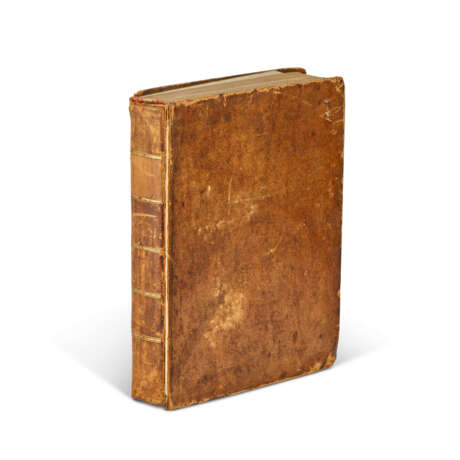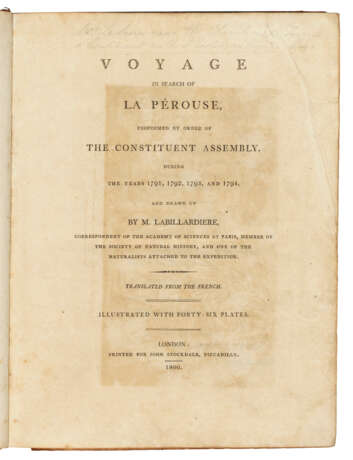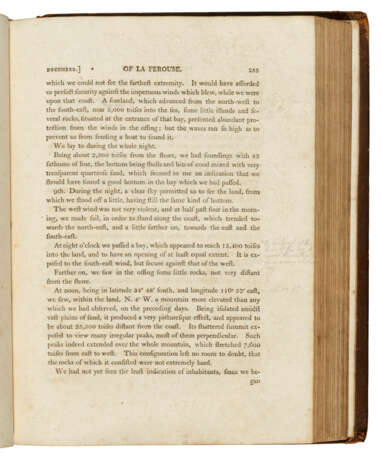ID 1349697
Lot 130 | LABILLARDIÈRE, Jacques Julien Houton de (1755-1834)
Estimate value
£ 40 000 – 60 000
Voyage in Search of La Perouse. London: John Stockdale, 1800.
Matthew Flinders’ own copy of d'Entrecasteaux’s expedition in search of La Pérouse, almost certainly taken with him aboard HMS Investigator on the first circumnavigation of Australia. With autograph annotations by Flinders correcting Labillardière’s geographical descriptions and mocking the author’s character.
The search for La Pérouse, two years after his disappearance, was undertaken by Admiral Joseph-Antoine Bruni d'Entrecasteaux onboard the Recherche, and Huon de Kermadec on the Espérance. The voyage was fortunate in having the eminent botanist Labillardière among its savants, and also the leading French hydrographer Charles-François Beautemps-Beaupré whose maps, particularly of Tasmania, 'set a new high standard' (Hill). In addition to hunting for La Pérouse, d'Entrecasteaux was instructed to chart the still unknown south coast of Australia. Labilladière's account of the voyage, the first statement by a member of the d'Entrecasteaux expedition, was published simultaneously in quarto and octavo in the original French, and followed in the same year by the first English edition, here in the superior single volume quarto format.
References to the accomplishments of d'Entrecasteaux are frequent in Flinders’ Voyage to Terra Australis (1814), and a footnote makes clear that Labilladière’s account was known to Flinders during his expedition: ‘While the Investigator sailed, the journal of M. Labilladière, naturalist in D'Entrecasteaux's expedition, was the sole account of the voyage made public'. Flinders also quotes directly from the English translation, providing references to page numbers which indicate that he possessed this single volume quarto issue. It is entirely likely that this was one of the ‘books of voyages to the South Seas’ which furnished Flinders’ cabin aboard HMS Investigator, alongside his set of Cook’s First Voyage and the Encyclopaedia Britannica given to him by Sir Joseph Banks (sold Christie’s King Street, December 15, 2021, lots 101 and 102).
Flinders’ pencil annotations, occurring across 9 pages and totalling 164 words and 4 corrections to co-ordinates, are principally concerned with Labilladière’s descriptions of the geography of Australia. He is rather bluntly critical, claiming that ‘Labillardière’s assertions are to be distrusted when they relate to geography.’ In other annotations he continues this distrust, writing that ‘The low beach at the head of this bay deceived the author: it is a very shallow bay’ and, beside a passage on the extent of Dutch explorer Pieter Nuyts’s voyage, that ‘This is a false assertion’. The most extensive annotation is a colourful rebuke to Labilladière’s character and an indictment of his understanding of Australia’s native inhabitants. Soon after reaching the South-West coast of New Holland, Labilladière records a series of ‘fires lighted along the coast’ which ‘sent up large columns of smoke, intended no doubt, by the inhabitants, to let us know that they were there’. Flinders, however, concludes: ‘These fires most probably arose from the grass and brush wood being set on fire to clear the country for walking and to catch the small animals. It is very likely that the natives did not see the ships, or seeing, did not understand them or take the least thought or care about them. The author something resembles the old woman with her new red petticoat – he thinks every body must be looking at him’. An intriguing annotation at the head of the title page appears to record a possible meeting between Flinders and a member of d'Entrecasteaux’s voyage: ‘Mrs LeSure near the church Cape Town a lieutenant with D’Entrecasteaux lives’. Ferguson 309; Sabin 38421.
Quarto (270 x 210mm). Folding engraved map and 45 engraved plates (short tear in margin of map and gutter of advertisement leaf, light offsetting from plates, one plate with faint stain to margin, some spotting and browning). Contemporary calf (covers detached, extremities rubbed, head and tailcaps heavily). Provenance: Matthew Flinders (1774-1814; pencil annotations) – two other pencil annotations in a print hand, possibly also by Flinders.
| Artist: | Jacques-Julien Houtou de La Billardière (1755 - 1834) |
|---|---|
| Auction house category: | Books and manuscripts |
| Artist: | Jacques-Julien Houtou de La Billardière (1755 - 1834) |
|---|---|
| Auction house category: | Books and manuscripts |
| Address of auction |
CHRISTIE'S 8 King Street, St. James's SW1Y 6QT London United Kingdom | |
|---|---|---|
| Preview |
| |
| Phone | +44 (0)20 7839 9060 | |
| Buyer Premium | see on Website | |
| Conditions of purchase | Conditions of purchase |








